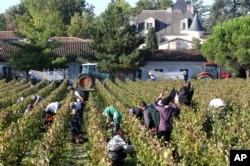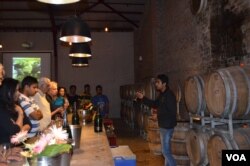The champagne is cooling in Paris in hopes of a successful conclusion to the U.N. climate talks.
But temperatures are warming in the province of Champagne itself, 90 miles to the east, about 1.5 degrees Celsius on average during the past several decades.
As in much of the world, weather extremes are coming more frequently here.
Grape-grower Jean-Pierre Vazart has 12 weather apps on his phone.
"Because I am a geek," he said, but also because storms and hail have become more severe.
"It's the fear everywhere," he said. "Each time the clouds become black, we imagine anything [could happen]." He'll compare weather forecasts on different apps and decide how he'll react.
Aside from the severe weather worries, however, Vazart says the region has mostly benefited from climate change.
"It's quite a good thing now," he said. "In the last 15 years, we had a lot of good vintages."
"At the moment, we don't mind the climatic changes," added Arnaud Descotes, joint technical director of the Comité Champagne trade association. "They translate into warmer temperatures and that means higher potential alcohol levels in our wines."
Among the lucky ones
In a world of climate change winners and losers, where rising temperatures, rising seas and weather extremes threaten to push more than 100 million people into poverty by 2030, producers of one of the world's top luxury goods can count themselves lucky.
Even within the wine industry, Champagne is on the winning side. According to a 2013 study in the Proceedings of the National Academy of Sciences, by 2050 the climate in some of the world's best-known winemaking regions is expected to become less hospitable to the vines, including France's Bordeaux and Rhone, and Italy's Tuscany.
Vineyards in California and parts of Argentina are already under pressure from shrinking water resources, according to Jean-Guillaume Prats, head of the wine division at Moët Hennessy.
But climate change is opening up new opportunities as well, Prats noted. Moët Hennessy has new vineyards in Maharashtra, India, above 3,200 feet in elevation, and in Inner Mongolia, "where we couldn't have produced wine 30 years ago because it was simply too cold," he added. "In that part of the world, global warming has a key impact."
Recognizing their role
But, Prats added, the industry takes seriously its obligation to reduce its contribution to climate change.
Champagne was the first French wine region to calculate its carbon footprint. Its winemakers now use slimmer bottles. The difference in weight is only 2.3 ounces, but "for 300 million bottles in a year, it's heavy," Vazart said.
The region has cut its greenhouse gases by 15 percent per bottle, largely due to the bottle change. And it plans to reduce them by 75 percent by 2050.
Grass grows between Vazart's vines, removing carbon from the atmosphere. And hedges line his fields, providing habitat for beneficial insects that will reduce the need for chemical insecticides. That won't make much of a contribution to climate change, but it's part of the industry's effort to reduce its environmental impact.
Many of the best-known brands have histories going back centuries, Prat noted.
"We do everything, not for the next generation, but for two or three down the road. We have a heritage that we know can easily go to waste if we don't take care of it."
"A hundred years from now, [computer-maker] Apple may not exist," he added, quoting parent company LVMH chairman Bernard Arnault, "but Dom Perignon surely will."









